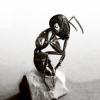You can start a mealworm culture, or freeze the extras for longer storage. I have two mealworm cultures at this point to try and keep up with the consumption rate of my colonies. I seperate a dozen mealworms or so and feed them with goodies like apples, oranges, etc to gut load them for a few days.
Actual blue bottle flies do tend to get into more chemicals than other flies, especially flying around the house. I feed wild insects often, but only if collected from locations with no chemicals and if they have been frozen.
I usually offer mealworms, crickets, and fruit flies as the main fare. I also offer my ants some table scraps. Bit of apple, bit of chicken, or just little bits of anything not salty or spicy. I buy and freeze my crickets from a pet store, too noisy and smelly.
A blacklight or bug zapper in a remote field can attract a lot of bugs for easy collection.


























